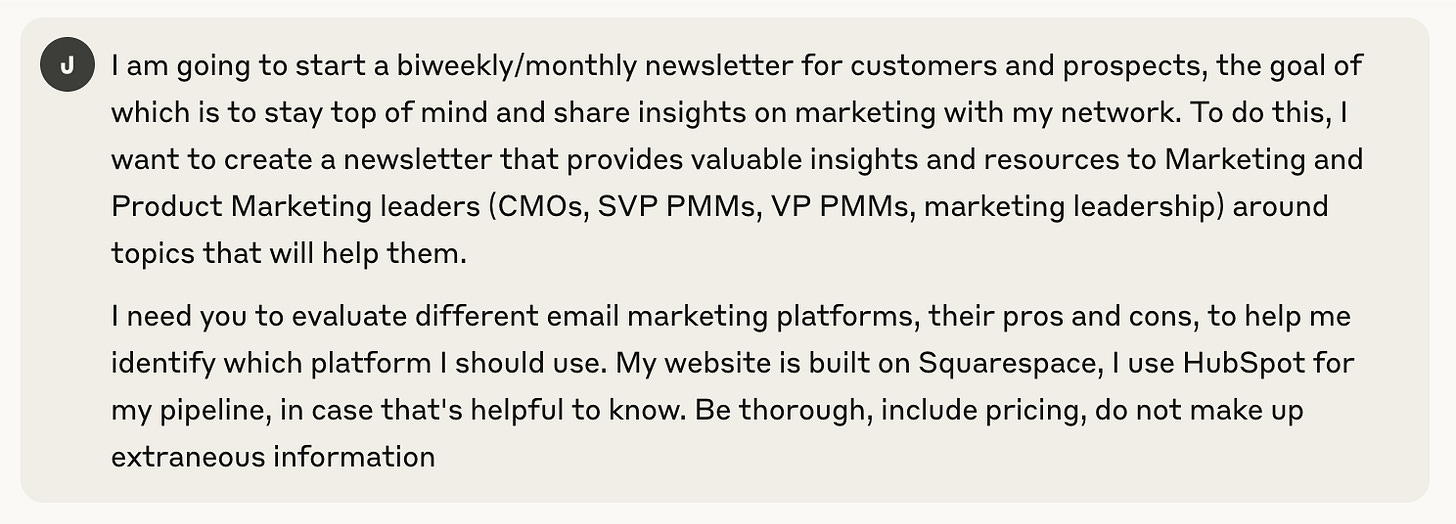Your website messaging isn't enough anymore
Why 89% of B2B buyers using AI tools means messaging consistency just got 10x harder
I’m a pretty decisive person. Once I make a decision, I stick to it and get it done. So when I decided last week that I’d start a marketing newsletter for clients and prospects, I dove in headfirst.
But in addition to decisiveness, overthinking is another one of my virtues. Much to the detriment of the newsletter, that meant I immediately began researching email marketing platforms to use, ultimately spending more time evaluating platforms than actually writing this email. I scoured the footnotes of every newsletter in my inbox (of which there are far too many): Kit, Flodesk, Squarespace, Substack, Klayvio, Marketing Cloud, Mailchimp…the list goes on.
So, I did what any good marketer does: I prompted Claude.
I’ll spare you the details (actually, you’ll see a full detailed breakdown on my Substack shortly), but this journey reminded me of something vitally important:
✨ MESSAGING CONSISTENCY ✨
Your consumers are no longer looking at your website’s L1 headline to know what you do. They’re looking to Claude or ChatGPT or Gemini to do the analysis for them. And here's the kicker: Forrester's research shows 89% of B2B buyers are using generative AI somewhere in their buying process. Meaning, your messaging needs to be differentiated and consistent not just on your website, but on your review sites, pricing pages, analyst reports, Reddit, you name it. LLMs look beyond your website for authoritative sources about your product, which means your messaging needs to be consistent across all these places. You can no longer rely on your website to be your source of messaging truth. It needs to show up everywhere.
The Three Layer Messaging Audit
What can you, as a marketing leader, do? I call it the Three Layer Messaging Audit:
Layer 1: Marketing-controlled sources (website, sales decks, release marketing) - most companies nail this, especially when they have a messaging source of truth doc to work with
Layer 2: Third-party sources (review sites, communities, customer success touchpoints, anywhere people are sharing their perspectives) - this is where most companies start to fracture
Layer 3: AI-discoverable sources (the stuff ChatGPT finds when prospects research you) - almost everyone is ignoring this
The companies winning right now treat Layer 3 like SEO used to be treated: as a systematic discipline, not an afterthought.
Here's what that actually looks like in practice:
Content Structure Audit: Start by auditing how your key messages appear when they're "chunked" by AI. Your 30-second elevator pitch might work great for humans, but AI tools prefer clear, quotable statements that start with the question they're answering. Instead of "We're the leading provider of...", try "When companies need [specific outcome], [your company] delivers [specific result] through [specific method]."
Source Authority Mapping: Identify every place your company gets mentioned online – G2 reviews, analyst reports, customer case studies, even Reddit threads. Then ensure your core value proposition appears consistently across all of them. If your website says you're "enterprise-grade" but your G2 reviews emphasize "ease of use," AI will aggregate both and muddy your positioning.
Citation-Worthy Content Creation: AI tools love to cite content that includes statistics, expert quotes, and specific comparisons. Create "AI-friendly" assets like comparison tables, FAQ sections that directly answer buyer questions, and data-backed statements that are easy for AI to extract and attribute. The goal isn't to game the system – it's to ensure that when AI aggregates information about you, it's pulling from sources that tell a coherent story.
The Big Takeaway
Your website messaging doesn't matter anymore if your G2 reviews, analyst reports, and Reddit threads all tell different stories. AI aggregates ALL of it, and prospects trust the aggregation more than your homepage. Start with an audit of what AI actually says about you.
Prompt ChatGPT with: "I'm evaluating [your company] for [use case]. What are the key benefits and differentiators?" The results will probably surprise you.
Are you a marketing leader? Sign up for my monthly newsletter for marketing leaders. You’ll get my industry insights and no-nonsense takes on what’s happening in marketing.


